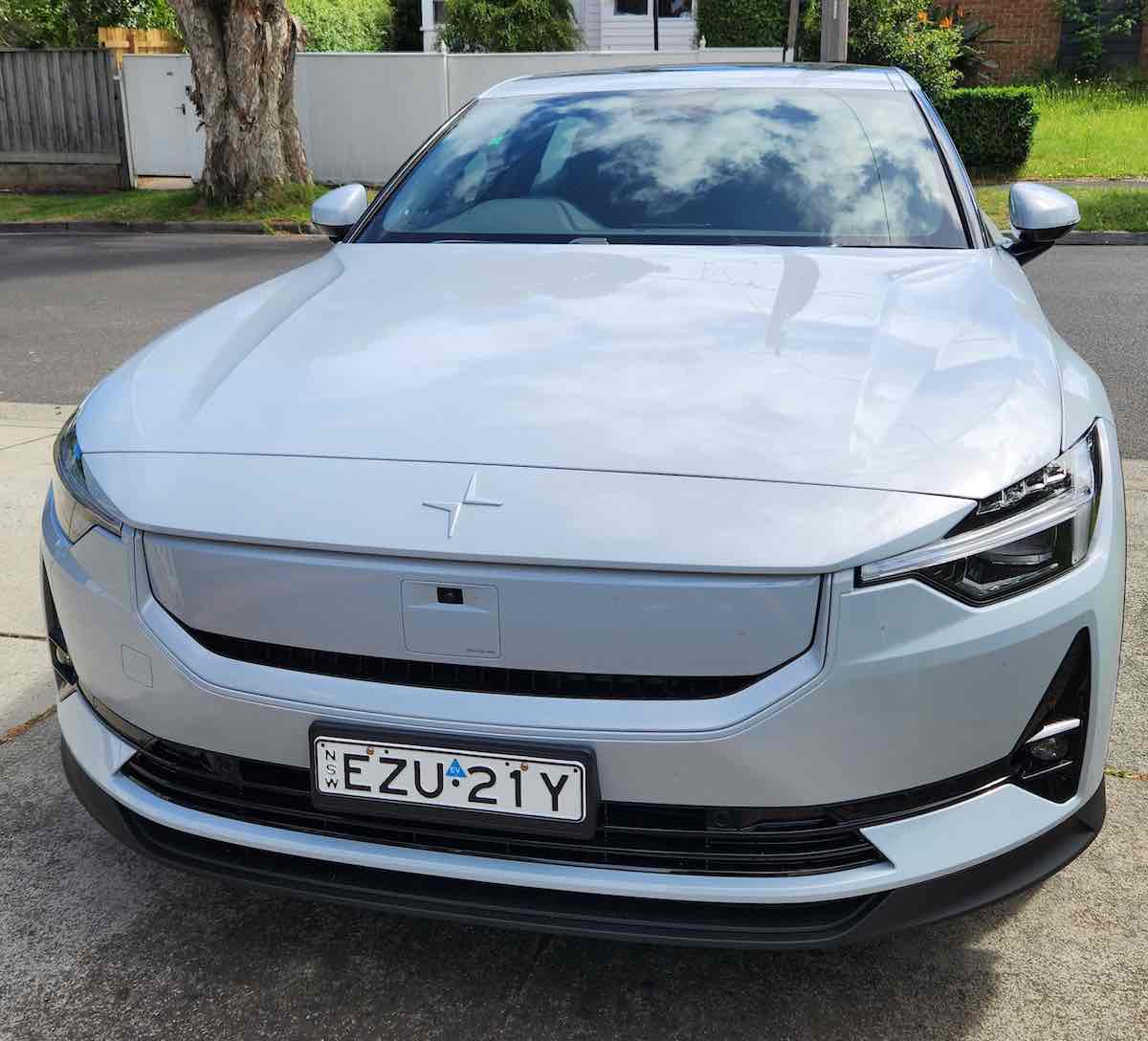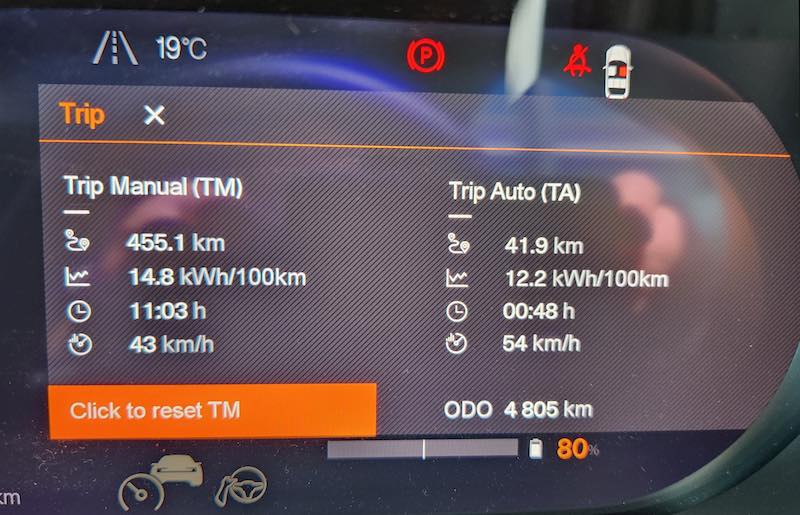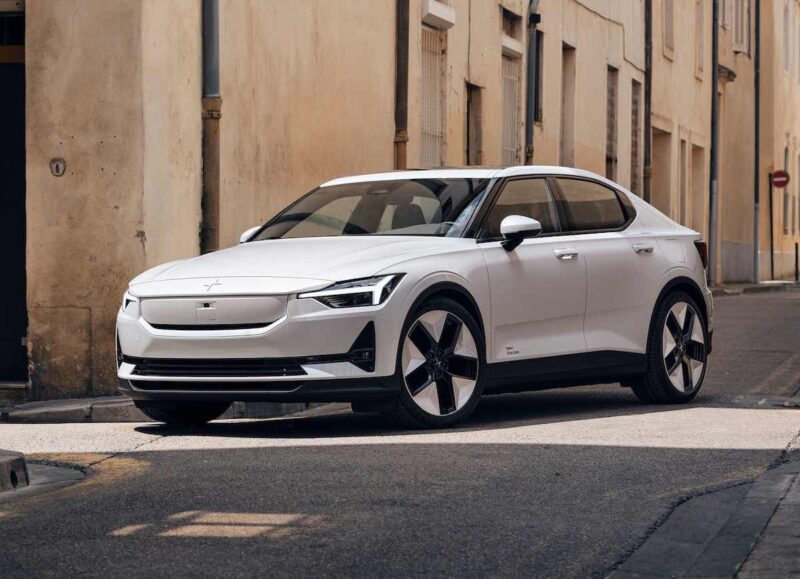The Polestar 2 was launched here back in 2021 with deliveries beging early in 2022. Then (and now) you had the choice of either two-wheel drive (2WD) and all-wheel drive (AWD) versions.
Originally it had a WLTP range of between 470 and 540km, depending on drive and performance options selected. Around that time I even had an extended drive of the AWD version … sadly, I never wrote up the report as soon afterwards I came down with Covid. (By the time I returned to the desk, so much work had piled up the poor Polestar fell off the list).
To cut a long story short, the take-home message from that drive was that whilst the Polestar 2 was an impressive car to drive, the range was surprisingly low (as well as not reaching the WLTP numbers) for a battery that size.
Anyway – fast forward to late 2023 and Polestar have launched a refreshed line-up of the 2 with more efficient drive-trains and, for the 2WD, moving the driven wheels to the rear.
Having recently spent a week with this revised version – I can say I was pleasantly surprised with the improvements, especially with the revised range. (The latter also being covered in Tim Eden’s recent report for The Driven here).
Changes for the 2024 update:
Externally, little has changed – although the first thing that strikes you is the removal of the black ‘egg crate’ style nose that looks for all the world like an ICE radiator grille.
In its place is a smooth, colour coordinated panel that not only makes it look more like an EV, it will be a whole lot easier to keep clean that the square indentations of the original. Other than that, the only other external change is some new design road-wheel options.

Internally, visually nothing whatever has changed. The large centre console and portrait 28 cm touch screen remain, as do the dash, seats, interior lighting etc. As officer Barbrady from South Park would say: “Move along people, there’s nothing to see here”.
The big changes are all underneath the skin. The suspension has been tweaked to give a slightly softer ride and, for the 2WD version, Polestar have moved the driven wheels from the front to the rear.
Power for the 2WD has been increased by 50 kW to 220 kW, whilst the AWD had had a modest power increase from 300 to 310 kW. Range has increased across the board through new design motors, inverters and other efficiency improvements plus a slightly bigger long-range battery. (From 78 to 82 kWh).
The standard range battery by the way remains the same at 69kWh. As a result – the longest range version (2WD, long-range battery) has a 655km WLTP range.
As I note in the EV model Fact Sheets I maintain through the AEVA website, whilst WLTP is a reasonably good estimate for city driving, the US EPA test cycle produces a better number for highway use.
For the Polestar 2, the US EPA number for the 2WD Long range is 515 km. Not 655 km (perhaps achievable in city traffic though) but still a long way on a single charge – and significantly better than the outgoing version which struggled in AWD guise to get much over 400 on the highway.
An interesting feature – as noted in Tim’s article – is the Polestar’s range estimator gave me a 540km estimate at a 100% charge rather than the WLTP number.
Like Tim, I found this to be relatively pessimistic given the kWh/100 km figures I was achieving. Based on those numbers, it would seem that the 2 could achieve the WLTP number in suburban driving. (As an example: I achieved 12.2 kWh/100 km for a combined suburban and freeway run of around 50km without heating or air conditioning).
By the way, the accumulated data for my test drive (left hand side of Trip screen shown) was for driving with either heating or air conditioning on. Melbourne weather in spring means one of them was needed at almost all times!

Driving
My first impression was to wonder why anyone would want to spend the money on the AWD version. With 220 kW and a 0 – 100 km time of 6.2 seconds, it moves very briskly off the line and I had no reason to feel the need to use full ‘throttle’.
Yes, the ride is on the firm side, but it was a tad softer than I remembered from my previous AWD version experience. Seating is also on the firm side, but it is very supportive and even after an extended driving stint I felt no twinges or discomfort on getting out again – but it does take a couple of days to get used to them.
As noted above, the ride is firm so some people may find it initially a tad ‘harsh’. By the way, that firm ride and lack of body roll comes into its own on tight, winding roads – making it a good candidate for a ‘weekend drive’ car. (Long weekends, yet again, NOT ruined 😉
Niggles
I did find a few niggles along the way. Adjusting the ventilation system via the touch screen I found to be very fiddly and involved a series of different menus to be accessed, meaning more time away from watching the road is needed if trying to make a change.
I ended up having to wait till traffic lights or other stops if I needed to swap a vent option or from heat to AC. Call me old-fashioned, but for ease of use, some things need to be left as simple switches and dials.
(This was not helped by the car doing an over-the-air update early into my weeks’ drive and reverting to the default settings in all things at the end of it – I had a hard time discovering where the main ventilation menu has disappeared to!).
On the subject of the OTA update – it is worth remember that, like a computer, don’t schedule one for when you need to use the car. The car shut itself off for 1.5hrs to do the download and update.
I hasten to add that these niggles are not specifically EV ones: cars in general are becoming more like portable touchscreen computers these days.
Another slight disappointment was the centre console – it is quite large and I would from time to time bump it with an elbow or leg, yet it serves no real function to justify the size. (It was good for bracing the left knee against on tight windy roads though 😉
Another omission is AM radio – which for a country cruiser would seem a good thing to have, given DAB and FM fade out quickly on longer drives, plus AM is often used for emergency broadcasts. (Some manufacturers are by the way bringing this feature back).
Whilst none of them was a deal-breaker, there are cars around with more functional layouts and controls than parts of the Polestar 2.
Pricing
Polestar has increased prices around $2500 to $3500 for the updated versions. (New prices shown below).
| Version | 2024 model price | Up by: (approx.) |
| Standard-range 2WD | $73,710 | $3500 |
| Long-range 2WD | $77,900 | $3000 |
| Long-range AWD | $83,088 | $3000 |
| Performance AWD | $92,466 | $2600 |
Option packs
So what do you get for your money? Standard now are a heat pump heating/air conditioning system, wireless phone charging, 360 degree ‘helicopter’ view when parking and the inclusion of a variety of safety features that formerly only came in an option pack.
Option packs are limited to ‘Pilot Pack’ and Plus Pack’ as well as a ‘Performance Pack’ option for the long range dual motor version.
The Pilot pack includes pixel LED headlamps with adaptive high beam, LED front fog lamps with cornering function and additional driving assistance systems. (Driver awareness with Adaptive Cruise Control, Pilot Assist and Emergency Stop Assist).
Plus pack inclusions are a full length panoramic roof, Harmon Kardon sound system, additional electric seat functions, ‘Vegan WeaveTech’ upholstery, an enhanced ventilation system with additional particulate sensor and air quality app – plus a few other items, including a ‘foot-wave’ operated tailgate. (As in you can wave your foot under the rear of the car and the tailgate will magically open or close).
The Performance pack addition for the AWD long-range includes a software power increase to 350 kW, 20 inch wheels, Brembo brakes with ventilated discs, adjustable dampers and ‘performance chassis’ upgrade.
The version I had was a 2WD with the long-range (82 kWh) battery and Plus Pack. As such, the on the road price in Victoria for it would be a shade over $84,000.
Personally, I wouldn’t bother with the Plus pack – in which case a ‘standard’ 2WD long-range would set you back around $77,900. (On the road, in Victoria. Other states have different incentives and discounts – check the Polestar configurator for exact pricing in your region).
Summing up
Driving the Polestar 2 for a week was ultimately a lovely experience, once I got used to its minor foibles. The dash layout provided all the most useful details (without clutter) in a well located position directly in front of the driver.
Setting up the driving position was easy with its electric adjustable seats plus reach and rake adjustments for the steering wheel. It drove well as a daily driver and performed better than most when driving more willingly on winding roads.
It was also a lovely change to be driving something that wasn’t yet another SUV. For the first EV buyer, it would make an easy swap and won’t produce any surprises (other than pleasant ones) in the change-over.
There are not too many options for steering wheel feel or regenerative braking – but the ones that are there are all that you really need to set yourself up. Personally, I like a bit more regenerative braking – but I am also a long-time EV driver and perhaps not the target market for the Polestar 2.
So it comes down to my usual question at the end of a test drive report: “would I drive it to Perth and back?” (I live in Melbourne by the way and have done that trip done before in my Kona electric).
Basically, the question covers is it a good EV that I like to drive, plus capable of the distances (respectable range and charging speeds), has enough luggage room, is comfortable enough to do so and would be as good as or better than my Kona for the trip.
My answer to that would be ‘yes’, although for me I would choose something slightly smaller and lighter as my day-to-day vehicle. Mind-you, that vehicle choice would want to include the handling characteristics of the Polestar 2.
Detailed specifications for the Polestar 2:
| Testing system range estimates | |||
| Variant | NEDC (Aust) | WLTP (Euro) | EPA
(USA) |
| Std range 2WD | Not rated | 546 km | NA1 |
| Long-range 2WD | Not rated | 655 km | 515 km |
| Long-range AWD | Not rated | 593 km | 444 km |
| Performance AWD | Not rated | 568 km | 398 km |
Seating: 5
Boot volumes in litres: (1 litre = 10 x 10 x 10 cm)
- Boot – seats up: 405 L*
- Boot – seat folded/to roof: 1,095 L*
* including 41 L under rear floor
- Froot: 31L (front boot: under-bonnet storage)
Dimensions:
- Overall length: 4,606 mm
- Overall height: 1,479 mm
- Ground clearance: 151 mm
- Overall width (edge of doors): 1,859 mm
- Overall width (edge of mirrors): 1,985 mm
Battery:
| Variant | Battery kWh
actual (usable) |
| Standard range | 69 (67) |
| Long-range: 2021-23
Long range: 2024 update |
78 (75)
82 (79) |
Energy consumption: (WLTP test cycle)
- 15.8 kWh/100km (LR, single motor)
Kerb weight:
| Variant | Kerb weight (kg) |
| Standard range 2WD | 2,019 |
| Long-range 2WD | 2,084 |
| Long-range AWD | 2,185 |
Charging:
- 1 phase AC: 7.4 kW max.
- 3 phase AC: 11 kW max.
- DC: 205 kW (long range), 135 (std range) max.
Charge port location:
- Rear left side
Drive configuration:
- Two wheel drive models:
- Front wheel drive: original release
- Rear-wheel drive: 2024 update model
- All-wheel drive (AWD)
Towing:
- 1500 kg braked/750 kg unbraked.
Performance:
| Variant | Max. Power
(kW) |
0 to 100km/h
(Sec) |
| Standard range 2WD | 220 (170)# | 6.2 (7.4) # |
| Long-range 2WD | 220 (170) # | 6.2 (7.4) # |
| Long-range AWD | 310 (300) # | 5.5 (4.7) # |
| LR AWD performance | 350 (350)# | 4.1 (4.2)# |
# Bracketed number: previous 2021-23 version

Bryce Gaton is an expert on electric vehicles and contributor for The Driven and Renew Economy. He has been working in the EV sector since 2008 and is currently working as EV electrical safety trainer/supervisor for the University of Melbourne. He also provides support for the EV Transition to business, government and the public through his EV Transition consultancy EVchoice.


